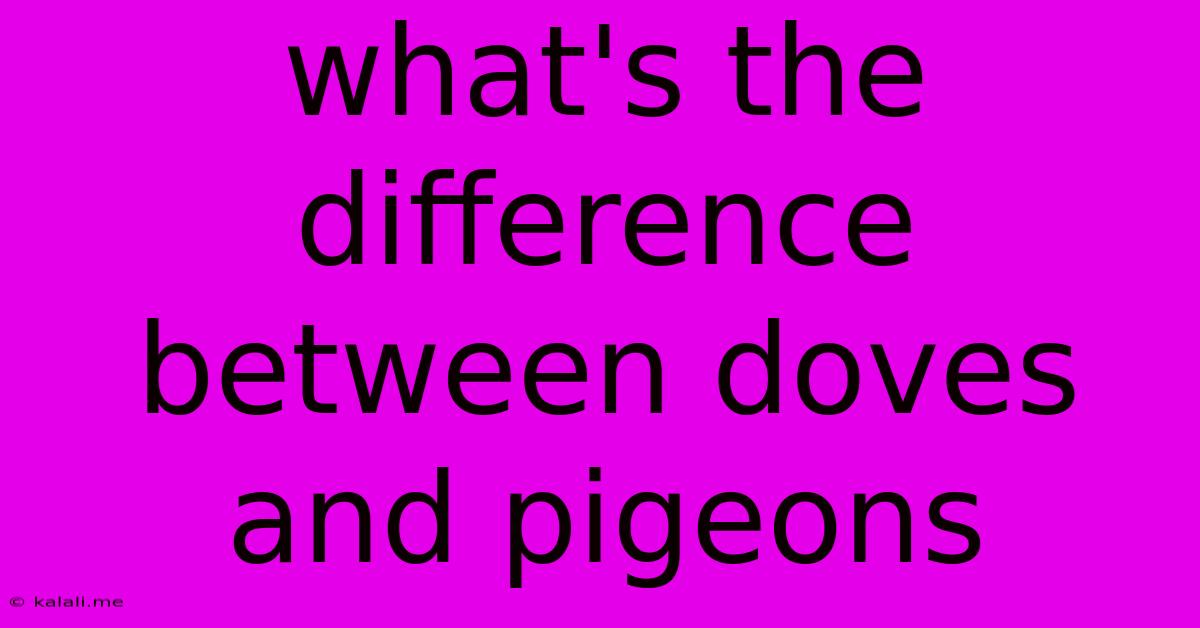What's The Difference Between Doves And Pigeons
Kalali
Jun 03, 2025 · 3 min read

Table of Contents
Doves vs. Pigeons: What's the Difference?
Doves and pigeons often get confused, and understandably so! They share a lot of visual similarities, belonging to the same family, Columbidae. However, there are key distinctions that, once understood, make identifying them much easier. This article will delve into the nuances separating these two seemingly similar birds, covering their physical characteristics, habitats, and behaviors. Understanding these differences will enhance your bird watching experience and improve your ability to distinguish these fascinating creatures.
Physical Characteristics: A Closer Look
While there's considerable overlap in appearance, some key physical characteristics can help differentiate doves from pigeons.
Size and Shape: Generally, pigeons tend to be larger and more robust than doves. Their bodies are more heavily built, and they possess a more substantial, stockier neck. Doves, conversely, often appear more delicate and slender.
Plumage and Color: Coloration is a less reliable indicator, as both doves and pigeons exhibit a wide variety of colors and patterns. However, doves frequently display softer, more pastel colors, such as pale blues, grays, and browns. Pigeons, on the other hand, can display a broader range, including bolder, more intense colors and markings. The Rock Pigeon, a common city dweller, is a prime example of a pigeon with a diverse range of color morphs.
Bill Shape and Size: The bill is often a more reliable distinguishing feature. Pigeons generally have longer, more robust bills, often appearing slightly hooked at the tip. Dove bills tend to be shorter, more slender, and less hooked.
Habitat and Behavior: Where They Thrive
The habitats and behaviors of doves and pigeons also offer further distinctions.
Habitat Preferences: While both can adapt to urban environments, doves often prefer more natural settings. They're commonly found in woodlands, fields, and other areas with more vegetation. Pigeons, meanwhile, are renowned for their adaptability and thrive in urban environments, parks, and even bustling city centers. Think of the ubiquitous Rock Pigeon.
Flight Patterns: Both doves and pigeons exhibit a similar undulating flight pattern, but doves’ flight tends to be more rapid and direct. Pigeons may have a slightly more lumbering flight. However, observing flight patterns alone can be unreliable for identification.
Social Behavior: Doves generally display less aggressive social behavior compared to pigeons. Pigeons are known to be more competitive and territorial, often found in larger flocks with a distinct social hierarchy. Doves might be observed in smaller groups or even as solitary individuals.
Common Species and Examples
To further solidify your understanding, let's consider a few common species:
- Mourning Dove: A classic example of a dove, known for its soft plumage and mournful coo.
- Rock Pigeon: The quintessential city pigeon, displaying a remarkable range of color variations.
- Ring-necked Dove: Another common dove species, easily identified by its distinctive ring around its neck.
Conclusion: Mastering the Art of Identification
While the lines can sometimes blur, understanding the subtle differences in size, build, bill shape, habitat preferences, and behavior can significantly improve your ability to distinguish between doves and pigeons. By carefully observing these characteristics, you'll be well on your way to becoming a more confident bird identifier. Remember, practice makes perfect! The more you observe these birds in their natural habitats, the easier it will become to spot the key differences.
Latest Posts
Related Post
Thank you for visiting our website which covers about What's The Difference Between Doves And Pigeons . We hope the information provided has been useful to you. Feel free to contact us if you have any questions or need further assistance. See you next time and don't miss to bookmark.